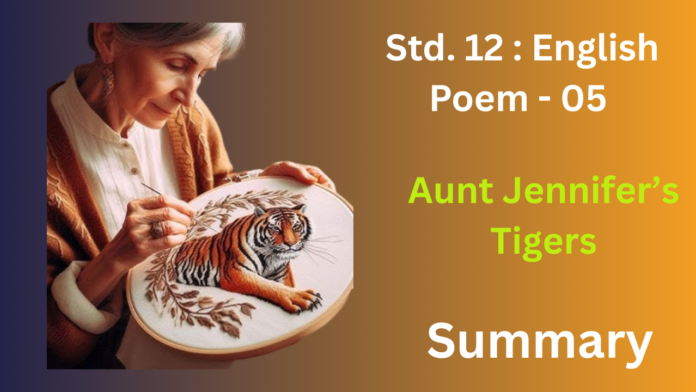The “massive weight of Uncle’s wedding band” on her finger symbolizes the heavy burden of her marital obligations and the lack of freedom she experiences.
While her artistic creation is bold, colorful, and assertive, Aunt Jennifer herself is timid and her “fingers fluttering through her wool” reveal her nervousness and the difficulty she has even with this creative outlet. The poem suggests that her art is a form of escapism and a silent rebellion against her restrictive reality.
Even in death, the poem implies that the “ordeals she was mastered by” will continue to mark her, while the tigers she created will forever remain proud, unafraid, and free, embodying the spirit she could not fully express in her lifetime. The poem poignantly explores themes of female oppression, the power of art as a form of resistance, and the enduring nature of creative expression beyond personal limitations.
Exercise
Think it out
1. How do ‘denizens’ and ‘chivalric’ add to our understanding of the tiger’s attitudes?
Ans:
The words ‘denizens’ and ‘chivalric’ significantly enhance our understanding of the tigers’ attitudes as portrayed in Aunt Jennifer’s needlework. ‘Denizens’ emphasizes that the tigers are rightful inhabitants and masters of their created world. They belong there, moving freely and confidently within their domain, unlike Aunt Jennifer who feels confined and oppressed in her own reality. This term establishes their inherent authority and natural ease.
‘Chivalric’ imbues the tigers with a sense of noble bravery, courtesy, and courage. This contrasts sharply with her timidity and the “massive weight” of her marital constraints. The chivalric tigers embody a spirit of freedom and power that Aunt Jennifer herself lacks, making them a symbol of her unfulfilled desires and a powerful form of escapist fantasy. These words together paint a picture of creatures that are the antithesis of Aunt Jennifer’s experience: bold, confident rulers of their own world.
2. Why do you think Aunt Jennifer’s hands are ‘fluttering through her wool’ in the second stanza? Why is she finding the needle so hard to pull?
Ans:
Aunt Jennifer’s hands are likely ‘fluttering through her wool’ in the second stanza due to a combination of nervousness and the physical toll of her oppressed life. The “massive weight of Uncle’s wedding band” symbolizes the heavy burden of her marriage and the lack of freedom she experiences. This psychological weight translates into physical anxiety, causing her hands to tremble or flutter as she tries to engage in her creative outlet.
She is finding the needle so hard to pull because this underlying anxiety and weariness have likely weakened her physical strength and dexterity. The act of needlepoint, which requires focus and steady hands, becomes a difficult task when one is burdened by emotional and possibly even physical constraints within a restrictive marriage. The heavy needle becomes a metaphor for the obstacles and difficulties she faces in expressing herself and finding freedom, even in this small act of creation.
3. What is suggested by the image ‘massive weight of Uncle’s wedding band’?
Ans:
It’s not merely a piece of jewelry but a symbolic representation of the heavy obligations, lack of freedom, and patriarchal control she experiences within her marital life. The word “massive” implies an immense and inescapable weight, both physically on her finger and metaphorically on her spirit.
It signifies a loss of individuality and the constraints imposed upon her by her husband and the institution of marriage in her context.
4. Of what or of whom is Aunt Jennifer terrified with in the third stanza?
Ans:
The “ordeal” refers to the oppressive experiences and lack of freedom she endured in her marriage, and the one who “mastered” her in this ordeal is clearly implied to be her husband, symbolized earlier by the “massive weight of Uncle’s wedding band.” Therefore, her fear is deeply rooted in her relationship with him and the control he exerted over her life.
5. What are the ‘ordeals’ Aunt Jennifer is surrounded by, why is it significant that the poet uses the word ‘ringed’? What are the meanings of the word ‘ringed’ in the poem?
Ans:
The ‘ordeals’ Aunt Jennifer is surrounded by are the oppressive constraints and lack of freedom within her marriage, symbolized by the “massive weight of Uncle’s wedding band.” It’s significant that the poet uses ‘ringed’ because a ring encircles and binds, just as her marital obligations have trapped and confined her.
The word ‘ringed’ has two key meanings in the poem:
- Physically bound: It refers to the wedding band on her finger, a tangible symbol of her marriage.
- Figuratively trapped: It also signifies that even in death, she will remain symbolically encircled and marked by the “ordeals she was mastered by,” indicating the lasting impact of her oppressive experiences.
6. Why do you think Aunt Jennifer created animals that are so different from her own character? What might the poet be suggesting, through this difference?
Ans:
Aunt Jennifer likely created the bold and fearless tigers in stark contrast to her own timid and oppressed character as a form of wish fulfillment and escapism. Through her art, she could project the strength, confidence, and freedom that she lacked in her own life. The vibrant, prancing tigers become a symbolic representation of her suppressed desires and a silent rebellion against the constraints of her marriage.
The poet might be suggesting several things through this difference. Firstly, it highlights the restrictive nature of societal expectations and patriarchal structures that can stifle a woman’s spirit and individuality. Aunt Jennifer’s art becomes a safe space where she can express the power and agency denied to her in reality. Secondly, it underscores the power of art as a means of self-expression and a way to transcend personal limitations, even if only in imagination. The tigers, once created, possess an enduring freedom that Aunt Jennifer herself could never attain, suggesting that art can outlive and even defy the constraints of a person’s life. Finally, it poignantly illustrates the internal conflict between Aunt Jennifer’s outward demeanor and her inner longings for liberation and self-assertion.
7. Interpret the symbols found in this poem.
Ans:
Here’s a shorter version of the analysis of symbols in “Aunt Jennifer’s Tigers,” avoiding plagiarism:
The poem uses rich symbols to explore oppression, freedom, and art’s power. The tigers embody untamed strength and fearlessness, contrasting with Aunt Jennifer’s timidity and representing the freedom she lacks. The needlepoint is her canvas for creating the autonomy denied to her. Her fluttering hands and the heavy needle symbolize her nervousness and difficulty in expressing herself under marital burdens. Uncle’s “massive” wedding band represents oppressive marital control and lost identity. Even in death, her “ringed” hands show the lasting impact of these struggles, while the tigers’ prance symbolizes art’s enduring power to express a freedom that outlives her.
8. Do you sympathise with Aunt Jennifer. What is the attitude of the speaker towards Aunt Jennifer?
Ans:
Yes, it is highly likely that one would sympathize with Aunt Jennifer. The fluttering of her hands and the difficulty she has pulling the needle further emphasize her nervousness and the physical toll of her situation. The fact that even in death, the “ordeals she was mastered by” will still mark her suggests a lifetime of subjugation.
The speaker observes her plight and seems to admire her attempt to find freedom and self-expression through her art. There’s a sense of sorrow for her situation and a recognition of the power of her creative spirit, even if it remains confined to the realm of her needlework. The speaker’s focus on the contrast between Aunt Jennifer’s reality and the boldness of her creation suggests a desire for her liberation and a recognition of the tragedy of her unfulfilled potential. The poem can be read as a lament for women trapped in oppressive circumstances, and the speaker serves as a voice acknowledging and validating Aunt Jennifer’s silent suffering and yearning for freedom.


